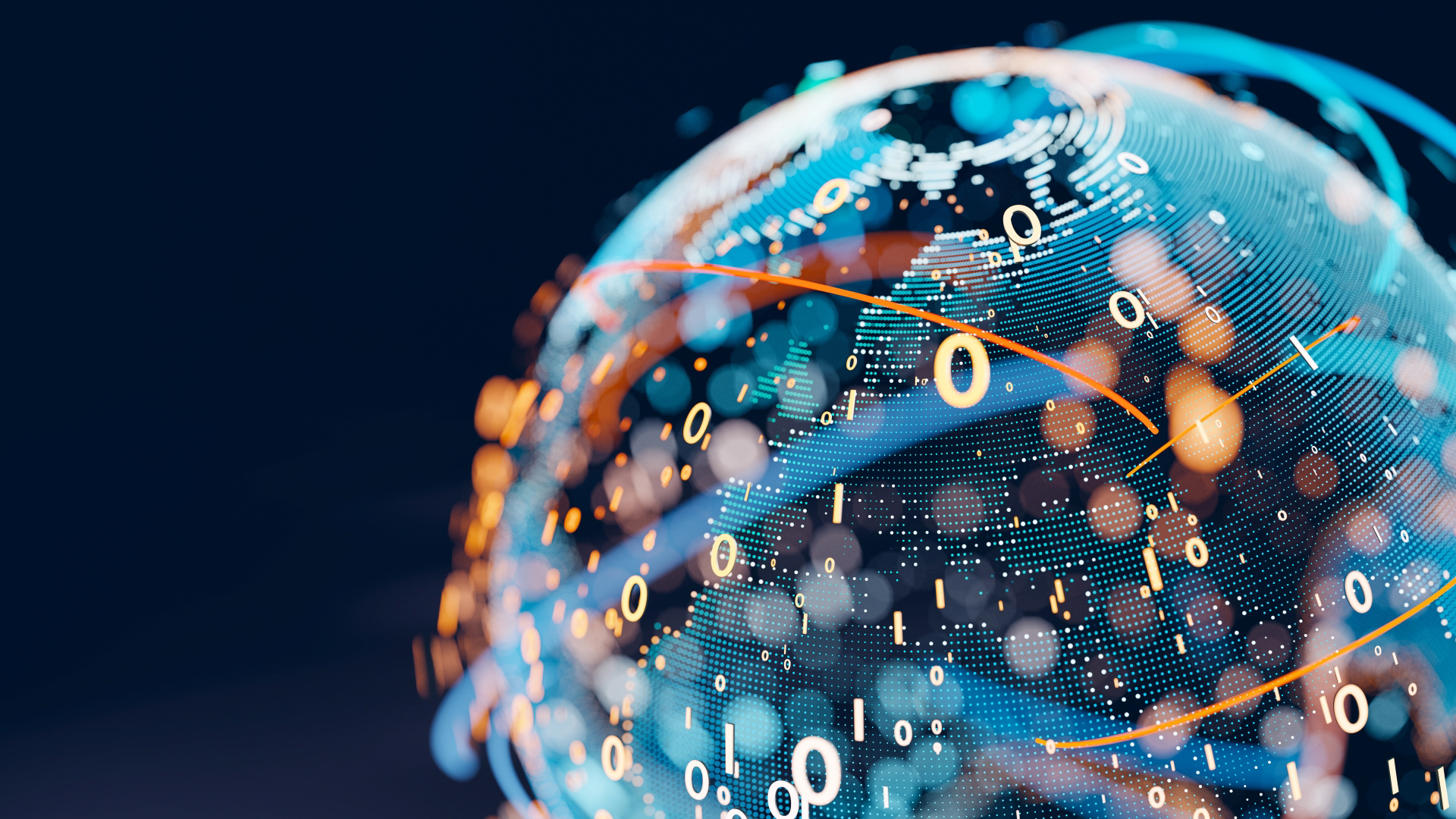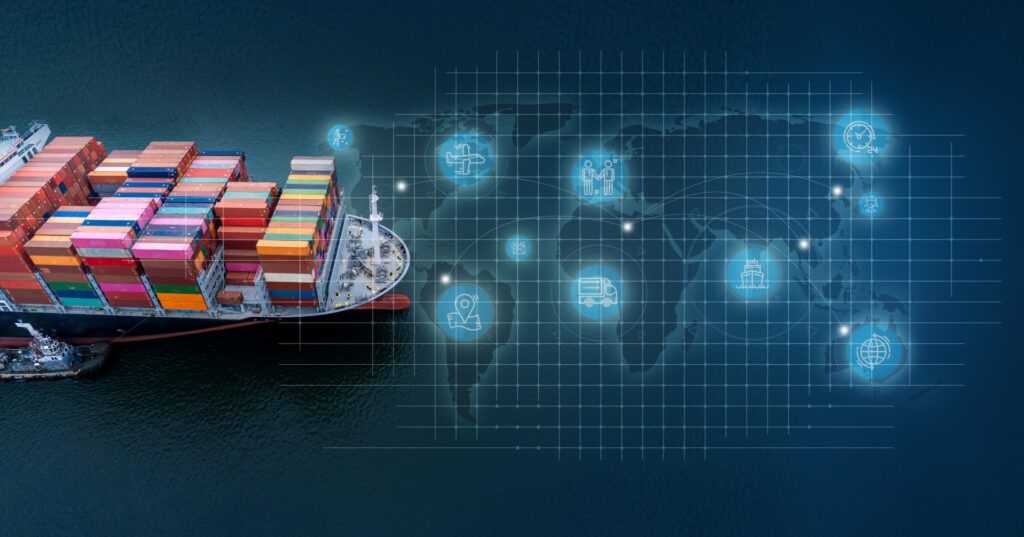This is a guest post by Jaco Voorspuij and Thierry Grumiaux from GS1. Both Jaco and Thierry are key contributors to our upcoming Certificate in Digital Trade Strategy, which you can read more about at the end of this post. Please note the views shared in this post do not necessarily reflect those of ICC Academy.
Today international supply chains face a multitude of challenges in moving products from where they are, to where they should be smoothly, in good condition and at the right time. The reasons for these challenges are many but the root causes are just a few. The title of this blog summarises the main cause.
Products/cargo will not cross borders unless stakeholders in the cross-border procedures and supply chain processes have the data they need, at the time they need it.
Crises like COVID-19, sanctions, restrictions and prohibitions, transport network disruptions (Suez Canal blockage, rivers running dry) can be addressed only by ensuring the right data is available at the right time at the right place. This enables the right stakeholders to make the appropriate decisions based on the best available data.
The problem is not so much the collection of data, but rather to ensure consistency of all the data collected, and in addition to interconnect the systems and tools used to enable real-time management.

Today, there are too many players each doing their own thing, there is a lack of coordination in terms of information exchange, and little interoperability. The multiplicity of players, standards, platforms and initiatives in the form of consortia or associations clearly highlights this challenge.
In our view, there should be harmonisation, standardisation, a “common language” that would allow all these systems to become digital and interconnected.
Global standards and identifiers – proven solutions for well over 50 years
Logistics is recognised in the professional and academic world for the creation of international standards such as the container, the barcode, and RFID, all of which are counted by the BBC among the “50 Things that Made the Modern Economy”.
The digitalisation of international supply chains faces the challenge of bringing together different standards from one end of the planet to the other, between players who do not have the same objectives, such as:
- Exporters and importers
- Carriers
- Insurers
- Banks
- Customs authorities.
This is where global, neutral, unambiguous identifiers, like the ones published by GS1 play an important role.
Identifiers
Identifiers are the ‘name’ and/or ‘ID’ of ‘objects’ and ‘subjects’ such as products, packages, persons, entities, carriers, containers, trade documents and any other physical or digital items in supply chain and related data exchanges.
Subjects are legal entities and natural persons with rights and obligations; objects are entities without rights and obligations.
The Toolkit document published by ICC/WTO, provides an overview of the most relevant subjects and objects that need to be identified.
Identifiers are a key building block for integrating data within organisations, between business partners and across sectors and industries. From physical procedures to digital data interchanges and workflows, an identifier is the ‘bridge’ between a physical ‘thing’ and its associated data, a virtual entity or a digital twin in an information and digital environment.
All supply chain actors would benefit from a consistent reference to established identifier standards.
Obviously, anyone can create their own identifier and identification for their closed applications and systems. In general, those intra-company or trading group identifiers will not be based on global data standards.
Standards
However, using globally accepted and standardised identifiers and code schemes can unlock great advantages for trade partners as they participate in the global or regional economy and international trade. This would facilitate the creation and sharing of unique ‘end-to-end’ identification of subjects and objects, resulting in richer, high-quality data in the international supply chain. It would also increase the ability to track-and-trace.
The most important thing overall is to make sure that there is a common language to facilitate the exchange of electronic data (to ensure “what is sent is what is understood” . This concept can be summarised in one word: interoperability.
Example
As an example, the ISO/IEC 15459 standard is the foundation for unique identification schemes.
This standard makes it possible that different stakeholders will generate unique and unambiguous identifiers without those stakeholders knowing about identification numbers issued by other stakeholders.
For example, one manufacturer may assign codes to his products based on this standard and another may also assign codes to his products. Both manufacturers can be sure that their product codes are unique and do not overlap with codes from the other manufacturer.
ISO 15459 covers unique identification for a very wide range of objects and subjects that are common in supply chains such as products, product packages, transport units, transport equipment and items and groupings of those.
Many organisations and companies have based their identification schemes on this ISO standard. Those identification schemes are interoperable and GS1 standards are fully compliant with ISO standards.
Product identification
Knowing what goods are being handled is a key question throughout supply chains and unambiguous product identification is a key enabler for smooth cross-border flow of goods.
The product identifier may be linked with data such as HS-code (Customs) or product classifications.
Global Trade Item Numbers (GTIN) can be used by a company to uniquely identify all its trade items. Trade items are products or services that are priced, ordered or invoiced at any point in the supply chain.
Groups of trade items with similar production and usage characteristics such as production batches can be further identified and linked to data like certifications, expiry dates and so on. Even individual trade items like machines or technical or medical devices may be identified uniquely using global data standards.
A globally unambiguous product identifier (like the GTIN) provides a common language for all entities and trading partners worldwide to easily communicate information about the item.

The GTIN can be encoded in a barcode or an RFID tag.
By scanning the barcode or RFID tag, companies can efficiently and accurately process products and related information. GTINs may be used when receiving goods in a warehouse, when administering medication in a hospital or vaccination centre as well as for identifying trade items online, and in electronic messages such as purchase orders and invoices or declarations for cross-border procedures.
Identifying location
Knowing where things happen and where they are is a key challenge in moving goods from where they are to where they should be.
Because the logistics industry is always addressing physical movements in which multiple parties are involved, the unambiguous identification of the location is relevant for all aspects of logistics. The Global Location Number (GLN) is an ISO-compliant identifier for locations that may be commonly used by all stakeholders in supply chains.
Locations come in many different sizes and kinds. They are often also “grouped” in hierarchies where larger locations contain (multiple) smaller locations.
Example
Take a warehouse or university campus as an example. Each of the areas and buildings within the campus have their own unique GLN identification number (Global Location Number).
The “parent” GLN identifies the entire campus area.
The other “child” GLN may all be linked to the “parent” GLN to indicate they are contained in the place identified by the “parent” GLN.
Hierarchies provide an easy way to understand and navigate complex structures that we encounter in many areas of our daily lives.

The GLN does not intend to replace the existing identifiers commonly used worldwide but aims to link those identifiers together to facilitate data exchange, using a common neutral identifier.
A GLN can act as an additional database key which references location-specific information that is stored in existing databases using other identifiers. Following this approach, the GLN may be used to find and access location information in both new and long-existing databases and applications.
This approach is valid regardless of the type of location, in any mode of transport and any node in transport and logistic networks.
At last we can be sure about ‘where’ – regardless of the type of location we are looking at in the supply chain.
This will enable supply chains to unambiguously communicate and reference location master data in a standardised and easy-to-use way, and as a result it will provide a foundation for additional value creation by third parties.
With the increase in extended, complex and highly global supply chains, tracking and tracing containers, consignments, shipments and products from end to end has become more difficult.
Conversely, there is now a higher demand, both from consumers and governments for more complete supply chain information to be shared before consumption or importation of products. Tracking and tracing throughout the supply chain can be achieved successfully if it is built upon global, interoperable standards that can act as the foundation for clear, understandable exchanges of information for all stakeholders.
Global data standards (such as the GTIN and GLN from GS1) create a common foundation for business by uniquely identifying, accurately capturing and automatically sharing vital information about products, locations, assets and more. Global Data Standards enable organisations to access a common language that underpins systems and processes all over the world.
In addition, digital technologies provide tremendous enhancements to current processes and enable contactless and paperless trade. When these technologies are combined with global data standards, they can bring future-proof transformations to international trade that will survive normal times and crises alike.
The language of global standards enables interoperability between devices and systems, and it accelerates novel possibilities for data and information sharing. They aim at “Bridging the physical and digital worlds” to improve and secure worldwide data exchange.
Learn more
In November, ICC Academy will be launching a brand-new online training programme, the Certificate in Digital Trade Strategy (CDTS). Jointly produced with the ICC Digital Standards Initiative, this unique course will give you a complete, end-to-end picture of what is needed to digitise your trade and supply chain processes, including digital identifiers.
The new certificate brings together insights from a well curated panel of more than 20 industry champions, legal experts, innovative trailblazers and public policy officials including the authors of this post, Jaco Voorspuij and Thierry Grumiaux from GS1.
Jaco and Thierry author the lesson “Digital identifiers for products and objects in the physical supply chain” from our module on exchanging trade and supply chain data in a trusted environment.
If you would like to know more about this new certificate, you can find out more here.

Certificate in Digital Trade Strategy (CDTS)
Certificate in Digital Trade Strategy (CDTS)
Available Now



